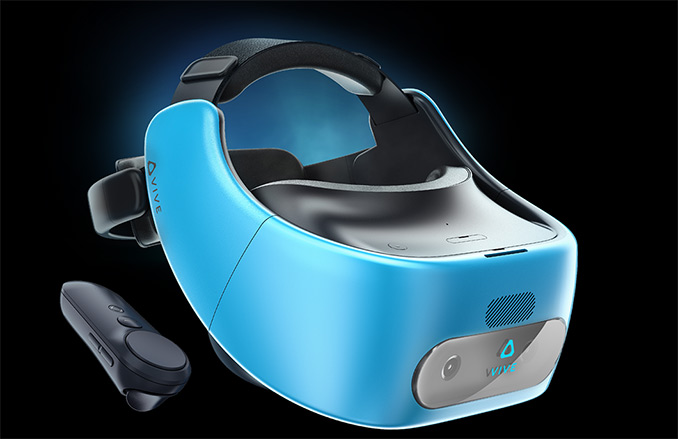HTC’s Standalone Vive Focus to Launch Worldwide This Year
by Anton Shilov on March 22, 2018 10:00 AM EST- Posted in
- VR
- HTC
- Qualcomm
- Snapdragon 835
- Vive
- VIVE Standalone VR
- Vive Focus

HTC announced this week that its standalone Vive Focus VR headset with six-degree-of-freedom tracking (6DoF) will hit the market worldwide later this year. In a bid to ensure that there is content for the Vive Focus on the market by the time it arrives to retail outlets, HTC is making available appropriate developer kits to registered software makers in most countries starting immediately.
The HTC Vive Focus VR handset is based on Qualcomm’s Snapdragon 835 SoC, has an AMOLED display featuring a 2880×1600 resolution, and a 75 Hz refresh rate. The device is equipped with some DRAM (unspecified), storage (expandable using a microSD card), 802.11ac Wi-Fi, and inside-out 6-degree-of-freedom tracking (6DoF) that does not require any external sensors for positional tracking. The key feature of the Vive Focus is that it can be used everywhere without any PC or base stations: just wear it and the battery allows for use for up to three hours. As for controls, the Vive Focus will come equipped with a relatively simplistic Bluetooth 3DoF controller akin to those supplied with the Samsung Gear VR headset.
The Vive Focus relies on HTC’s Vive Wave open VR platform and toolset that supports both standalone and PC-based Vive headsets. Content for the Vive Focus will be available from the Viveport store. To lure more developers to the platform and to the store, HTC will hand software makers 100% of revenue from title sales and Viveport subscription in China between April and September 2018.
Having cancelled all of its Google Daydream efforts and sold some of its smartphone-related assets to Google, HTC has naturally become more focused on its own VR hardware and platforms. As a result, it is not surprising that the company is getting more aggressive with its virtual reality projects, which includes plans to launch the Vive Focus globally as well as attract more developers to its VR platforms in China.
HTC’s Vive Focus is available in China now for ¥3,999-¥4,299 ($540-580 without tax), depending on the product bundle (with four or six free games). The manufacturer yet has to announce MSRPs for Europe and North America, but it is highly likely that they will be comparable to prices in China.
Related Reading
- HTC Announces Standalone Vive Focus with 6DoF Tracking, Cancels Daydream VR Headsets
- Oculus Announces Oculus Go: Untethered VR For $199 USD
- Dell’s Visor Available for Pre-Order: A Mixed Reality Headset, Ships in Mid-October
- Dell Enters VR Arena With "Visor" HMD
- HTC Announces Snapdragon 835-Based VIVE VR Headset for Chinese Market
Source: HTC











13 Comments
View All Comments
PeachNCream - Thursday, March 22, 2018 - link
Standalone VR headsets make a lot more sense than PC-tethered models, but the amount of compute and graphics power you can stuff into a headset and power with a battery needs to improve significantly before we reach a point where the desktop isn't relevant. I'd go out on a limb and say that if VR remains marketable for another six years, we'll be a lot closer to shedding the conventional PC on a full-time basis. There are a lot of barriers to reaching that point though so who knows.Tylanner - Thursday, March 22, 2018 - link
I don't think you're giving wireless video technology enough credit. When looking at the relative scale between our current workstations and a truly capable and comfortable Standalone VR it seems much farther off than compact, cheap and latency free wireless HD/4k video.PeachNCream - Thursday, March 22, 2018 - link
I guess I didn't really consider wireless video because, after trying to use WiFi for Steam in-home streaming and getting poor video quality at resolutions over 720 from a 1 Gbps ethernet port to a wireless N laptop, it just strikes me as a bad idea to try to do any latency sensitive and relatively high resolution VR without a cable right now. Maybe it'll be better soon, but VR is already a sort of nausea inducing mess right now without wireless transmissions adding their own problems. It'd be better for all of us to move VR into a post-PC state by doing all the game processing locally inside the headset. Desktops have their purpose and place, but I don't think tethering VR to them is an elegant long-term solution for the industry. It's fine as an emerging platform, but in the end, it can't be the status quo and gain widespread adoption.SaberKOG91 - Thursday, March 22, 2018 - link
Not even remotely the same thing. Steam in-home streaming has to use to video encoding and decoding and then deal with lossy wireless transfers. That gets even worse when you have more devices on that same wireless access point. The wireless video tech for VR is looking like 60GHz point-to-point. That means no sharing with other devices and no need for software decoding. These can be purpose built devices that translate raw digital video streams from transmitter to receiver, without the need for latency inducing compression or codecs. Better still, this all happens external to the computer, so there will not be a hit to performance over a direct-connection either. Go take a look at the Anandtech article on AMD's Nitro acquisition. They claim enough bandwidth for uncompressed 4k120. That's more than enough for the sub-4k 90fps needed for smooth VR.modport0 - Friday, March 23, 2018 - link
As SaberKOG91 said, VR companies are looking more at point-to-point (PtP) wireless systems likely in the 60 GHz frequency. If they're not coming up with their own proprietary standard/modulation scheme, they may be looking into IEEE 802.11ay with supposedly a 20+ Gbit/s data rate per stream (up to 4 streams for 100+ Gbit/s). That's pretty fast even if the data rate is slowed some if an environment needs to go to lower modulation orders and/or lower channel code rates. As for interference, you probably can't have more than 1 VR device per room so some commercial applications would be difficult. With less interference and being PtP, the transmission latency would be very low compared to standard Wi-Fi. Processing latencies in the ASICs is still TBD though.A typical issue with all technology is how much will this add to the cost of the device. Not sure how much a vendor can sell a device at a loss even if they can recoup the money through other means like software fees via their own app store.
mode_13h - Monday, March 26, 2018 - link
That comment said nothing about PC VR not being wireless.I agree with it, as written (and interpreting tethered in a logical sense - not as in a physical cable), yet I think wireless PC VR will be the norm by 2019. I'm actually surprised Vive Pro didn't launch with it.
mode_13h - Monday, March 26, 2018 - link
To expound on this, the standalone aspect is a true game-changer. You can use these things *anywhere*.However, if you're just going to be at your PC, then you might as well use a Windows MR HMD and benefit from its vastly superior rendering horsepower and all the other advantages the PC platform has to offer. Yet, they still free you from needing cameras, lighthouses, etc.
stephenbrooks - Saturday, March 31, 2018 - link
--[You can use these things *anywhere*.]--But would people really do that? It's the Google Glass social acceptability problem, plus, it better be a mixed-reality headset so you can see where you're going! It's not like a smartphone that you can just look up from or put it back in your pocket easily.
I think for gaming, people will use VR headsets at home in the same room the vast majority of the time. So tethering to a PC is not an issue, in fact it's an advantage.
Dragonstongue - Thursday, March 22, 2018 - link
to each own, but, the limited battery capacity (3 hours) and the wanted price (~$540+) at least for ME is expensive for limited ability in constant use, seems just another fancy gadget only meant to be used a short while for the "this is cool" factor...tetherless is one thing, but, limited time on usage is very much another, I rather have a tether (leading to a backpack if need be) and not really have to worry about power or connectivity issues than to run out of power when am in the middle of doing something and have to stop and recharge it.granted they do stuff a lot of tech in there for the price "wanted" I feel they have quite a long ways to come before it is able to be more mainstream and less of a "for those who have the money to be wasteful" ^.^
mode_13h - Monday, March 26, 2018 - link
Who's to say you can't plug in an external battery pack?